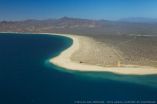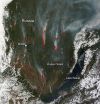(Press-News.org) Jon Grabowski, a marine science and fisheries expert at Northeastern University's Marine Science Center in Nahant, Massachusetts, has been working with other fisheries scientists as well as economists, social scientists, and policy makers to determine the best strategies for dealing with all of the Northeast region's fisheries that impact habitat, which includes cod, haddock, cusk, scallops, clams and other fish that live near the sea floor and are of significant socioeconomic value to the region.
In research published online last month in the journal Reviews in Fisheries Science & Aquaculture, Grabowski found that mobile fishing gear such as trawls and dredges that drag along the bottom cause more damage to areas inhabited by groundfish than stationary gear like traps and gillnets. They also found that larger geological features, such as cobble and boulders, are more susceptible to damage and take longer to recover than sand and mud—after all, some of these geological features have taken millennia to form.
"We worry most about the components of habitats that are highly susceptible to any of these gears and that have very long recovery times. Those are the kinds of persistent and severe impacts that we'd want to manage against," Grabowski said. His research focuses on the many interconnecting arms of fisheries science and management.
Cod fishing in New England has steadily declined over the past three decades. It's estimated that hundreds of people have lost their jobs as a result and that continued failure to rebuild the fishery could cost the region's economy a total of $200 million, according to the New England Fishery Management Council.
But the big concern is really one of culture, according to Grabowski. "You're talking about an iconic fishery. Cod has been fished in these waters going back hundreds and hundreds of years," said Grabowski, an associate professor of marine and environmental science. "You can go back a thousand years to the Basques coming over to fish these historically really productive grounds," he said.
Grabowski's research is first in a series of articles where Grabowski and his colleagues examine the vulnerability of groundfish habitats to various types of fishing gear. "We reviewed how all the different geological and biological components of habitat are affected by these different types of gear," Grabowski said. The committee examined how easily these habitats can be damaged and how long it takes for them to recover.
The team uses these results to develop a framework that will provide fisheries managers a standardized method for identifying the most vulnerable habitats. Their work is being used as part of the Second Habitat Omnibus to inform redesigning of the fishing closures on Georges Bank and in the Gulf of Maine.
Grabowski said there are many stakeholders involved when dealing with complex challenges like New England's fishery problems. His approach focuses on interdisciplinary solutions to these challenges by examining not just the basic ecology of these species and their habitats, but also the ways in which the coastal communities are reacting to how fisheries are managed.
Grabowski compared himself to a cod—a generalist in the marine world—since he works across traditional institutional and sectorial boundaries to identify the best strategies and find ways to effectively implement them.
"At the end of the day," Grabowski said, "if we really want to do something about sustainability, we must be doing the kinds of things that involve policy and help shape the way society self regulates."
INFORMATION: END
Better science for better fisheries management
Mobile fishing gear, such as trawls and dredges that drag along the bottom of the ocean, cause more damage to areas inhabited by groundfish than stationary gear like traps and gillnets
2014-05-19
ELSE PRESS RELEASES FROM THIS DATE:
Predicting which stroke patients will be helped -- or harmed -- by clot-busting treatment
2014-05-19
Johns Hopkins researchers say they have developed a technique that can predict — with 95 percent accuracy — which stroke victims will benefit from intravenous, clot-busting drugs and which will suffer dangerous and potentially lethal bleeding in the brain.
Reporting online May 15 in the journal Stroke, the Johns Hopkins team says these predictions were made possible by applying a new method they developed that uses standard magnetic resonance imaging (MRI) scans to measures damage to the blood-brain barrier that protects the brain from drug exposure.
If further tests ...
Studies find existing and experimental drugs active against MERS-coronavirus
2014-05-19
A series of research articles published ahead of print in the journal Antimicrobial Agents and Chemotherapy have identified a number of existing pharmaceutical drugs and compounds under development that may offer effective therapies against Middle East Respiratory Syndrome (MERS).
In the first study, researchers screened a library of 290 pharmaceutical drugs, either FDA-approved or in advanced clinical development for antiviral activity against the MERS coronavirus (MERS-CoV) and severe acute respiratory syndrome coronavirus (SARS-CoV) in cell culture. They found 27 ...
Report finds site of mega-development project in Mexico is a biodiversity hotspot
2014-05-19
RIVERSIDE, Calif. — Cabo Pulmo is a close-knit community in Baja California Sur, Mexico, and the best preserved coral reef in the Gulf of California. But now the lands adjacent to the reef are under threat from a mega-development project, "Cabo Dorado," should construction go ahead.
Scientists at the University of California, Riverside have published a report on the terrestrial biodiversity of the Cabo Pulmo region that shows the project is situated in an area of extreme conservation value, the center of which is Punta Arena, an idyllic beach setting proposed to be completely ...
Different types of El Nino have different effects on global temperature
2014-05-19
The El Niño–Southern Oscillation is known to influence global surface temperatures, with El Niño conditions leading to warmer temperatures and La Niña conditions leading to colder temperatures. However, a new study in Geophysical Research Letters shows that some types of El Niño do not have this effect, a finding that could explain recent decade-scale slowdowns in global warming.
The authors examine three historical temperature data sets and classify past El Niño events as traditional or central Pacific. They find that global surface temperatures were anomalously warm ...
Does birth control impact women's choice of sexual partners?
2014-05-19
Birth control is used worldwide by more than 60 million women. Since its introduction, it has changed certain aspects of women's lives including family roles, gender roles and social life. New research in The Journal of Sexual Medicine found a link between birth control and women's preferences for psychophysical traits in a sexual mate.
The researchers utilized a PMI (Partner's Masculinity Index) to determine the male traits that women found attractive during the fertile phase of their menstrual cycle. The participants were from Central Italy and divided into two groups ...
Teens who participate in sports show lower levels of hazardous drinking
2014-05-19
New research in Criminal Behavior and Mental Health aimed to find the relationship between participation in organized sports and an increase in hazardous drinking. Unlike previous research, the study focused on an underrepresented group – young offenders – adolescents who were either excluded from school or involved with the justice system.
93 British male young offenders from a local Youth Offending Team participated in the study, as well as 53 non-offenders from local schools. Both groups had similarly low socioeconomic status. Participants were asked to partake in ...
Citizen scientists map the flyways of North American birds
2014-05-19
Flyways used by migratory birds as they travel across America have long been a topic of fascination for ornithologists. For larger species like waterfowl that are easily visible during their migratory flights, these flyways have been described, but until now the flyways for smaller-bodied birds have been largely based on conjecture.
New research in the Journal of Biogeography has used analyses of information from the eBird citizen-science database to describe week by week the distributions of 93 North American land birds. By determining the level of similarity in the ...
Wildfires around Lake Baikal, Russia
2014-05-19
Lake Baikal, which is usually still frozen over at this time of year, can clearly be seen in the image. At this time, though, the lake has lost all of its ice coverage already even though snow still surrounds it. Temperatures in this region have skyrocketed in the past few weeks to the 70s prompting outbreaks of fires. Temperatures are usually cooler until late July/early August when the bulk of the wildfires in this area normally erupt. Careless handling with fire and withered dry grass fires on the croplands reportedly were the main reasons for the fires.
The Voice ...
Several new apple varieties recommended for growers
2014-05-19
PARMA, ID – 'Fuji' apples have become increasingly popular among consumers, but the apple variety faces some challenges on its path to full consumer appreciation. Research has determined that "consumer acceptance" of apples depends largely on fruit color, size, eating quality, and texture. Consumers are very discerning: poor color can drastically reduce the value of red apples, even if their size is acceptable. The poor and inconsistent peel color of 'Fuji' apple strains has limited the apple's marketability. The authors of a new study say that the introduction of new 'Fuji' ...
Making better medicines with a handful of chemical building blocks
2014-05-19
CHAMPAIGN, Ill. — Soon, making and improving medical drugs could be as easy for chemists as stacking blocks is for a child.
University of Illinois chemist Martin Burke, a pioneer of a technique that constructs complex molecules from simple chemical "building blocks," led a group that found that thousands of compounds in a class of molecules called polyenes – many of which have great potential as drugs – can be built simply and economically from a scant one dozen different building blocks.
The researchers published their findings in the journal Nature Chemistry.
"We ...
LAST 30 PRESS RELEASES:
Norbert Holtkamp appointed director of Fermi National Accelerator Laboratory
New agentic AI platform accelerates advanced optics design
Biologists discover neurons use physical signals — not electricity — to stabilize communication
Researchers discover that a hormone can access the brain by hitchhiking
University of Oklahoma researcher awarded funding to pursue AI-powered material design
Exploring how the visual system recovers following injury
Support for parents with infants at pediatric check-ups leads to better reading and math skills in elementary school
Kids’ behavioral health is a growing share of family health costs
Day & night: Cancer disrupts the brain’s natural rhythm
COVID-19 vaccination significantly reduces risk to pregnant women and baby
The role of vaccination in maternal and perinatal outcomes associated with COVID-19 in pregnancy
Mayo Clinic smartwatch system helps parents shorten and defuse children's severe tantrums early
Behavioral health spending spikes to 40% of all children’s health expenditures, nearly doubling in a decade
Digital cognitive behavioral treatment for generalized anxiety disorder
Expenditures for pediatric behavioral health care over time and estimated family financial burden
Air conditioning in nursing homes and mortality during extreme heat
The Alps to lose a record number of glaciers in the next decade
What makes a good proton conductor?
New science reporting guide published for journalists in Bulgaria
New international study reveals major survival gaps among children with cancer
New science reporting guide published for journalists in Turkey
Scientists develop a smarter mRNA therapy that knows which cells to target
Neuroanatomy-informed brain–machine hybrid intelligence for robust acoustic target detection
Eight SwRI hydrogen projects funded by ENERGYWERX
The Lundquist Institute and its start-up company Vitalex Biosciences Announces Strategic Advancement of Second-Generation fungal Vaccine VXV-01 through Phase 1 Trials under $40 Million Competitive Con
Fine particles in pollution are associated with early signs of autoimmune disease
Review article | Towards a Global Ground-Based Earth Observatory (GGBEO): Leveraging existing systems and networks
Penn and UMich create world’s smallest programmable, autonomous robots
Cleveland researchers launch first major study to address ‘hidden performance killer’ in athletes
To connect across politics, try saying what you oppose
[Press-News.org] Better science for better fisheries managementMobile fishing gear, such as trawls and dredges that drag along the bottom of the ocean, cause more damage to areas inhabited by groundfish than stationary gear like traps and gillnets



